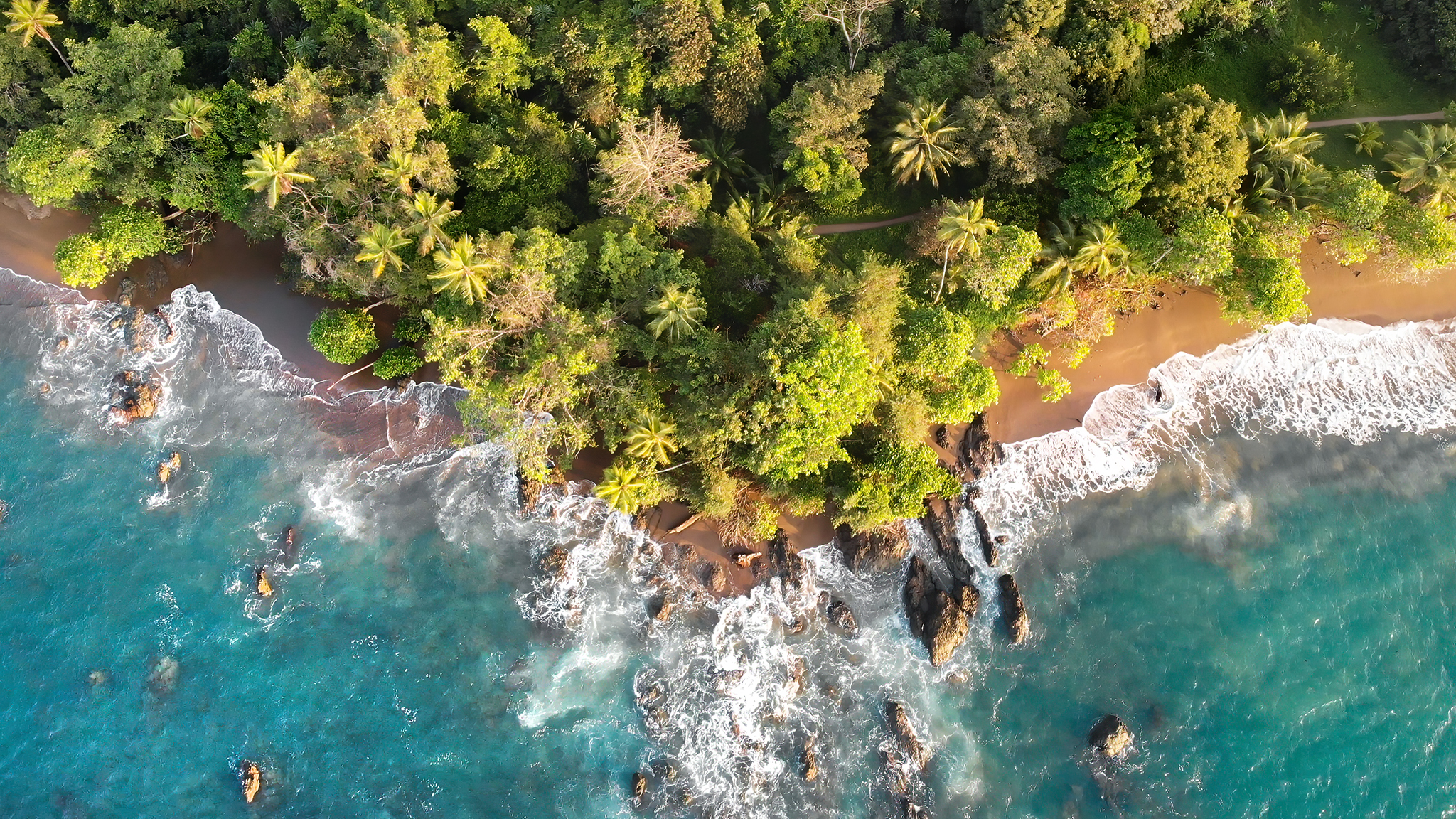Conservation and Community Collaboration on the Osa Peninsula: A Profile of the Corcovado Foundation
Costa Rica’s Osa Peninsula is one of the most spectacular places on the planet. Its stunning beaches have beautiful blue oceans on one side, home to whales and dolphins, and pristine rainforests on the other, where sleepy sloths sleuth through the trees. From spider monkeys to sea turtles, the region is home to a variety of endangered animals, which have found a place to thrive in this little patch of paradise.
However, the protection of this area was never a guarantee. In the late 1990s, as deforestation was running rampant, a group of dedicated individuals in the small town of Drake Bay came together with the goal of conserving the Osa Peninsula, and maintaining it as one of the world’s premier natural destinations. In the 25 years since, the Corcovado Foundation has grown significantly, and its scope has broadened into a combination of social and environmental work.
Today, the organisation has four key focus areas – environmental education, regenerative agriculture, rainforest restoration, and community support. In early 2023, I spent a few days with the Corcovado Foundation in order to learn more about the vital work they do in the region. I took part in a beach clean-up, worked on a sustainable agriculture project, visited community members with the goal of managing stray cat and dog populations, and, amongst all the bustle, sat down with Helena Pita – the foundation’s director of environmental education – to discuss her journey with the organisation.

Originally from Madrid, Helena came to Costa Rica 12 years ago as a volunteer with the Corcovado Foundation’s sea turtle conservation project. Initially, it was the natural beauty that drew her in.
“To arrive to Drake Bay for the first time – I think it’s like arriving to Jurassic World,” she says. “You feel like you’re arriving to a place that nobody has been before.”
After falling in love with the region and the local community, it was the flexibility of her work that led her to stay.
“I think I have been working for so many years with the foundation because I’ve been growing with the foundation. I haven’t felt that I’m doing the same job the whole time.”
Helena volunteered for a year and a half, and after transitioning to a full-time role in environmental education, she never looked back.

The Corcovado Foundation’s environmental education project adopts a two-pronged approach. Firstly, they focus on local communities, running sea turtle conservation programs for adults, and after-school activities for children.
“We work in five different communities,” Helena explains. “The kids come after school voluntarily, so the idea is that we teach them in a fun way… Sometimes we use art to teach something, sometimes we use games, sometimes we do excursions – we have different ways that we try to teach them about the environment.”
And this isn’t the only goal. Fostering a sense of community among the children is just as important as the content of the lessons.
“[We do] a lot of cooperation games, and just try to make a safe place for them, because there aren’t a lot of options for the children after school.”

In addition to their community-based education work, the foundation also collaborates with staff at Corcovado National Park to facilitate a Junior Ranger program with local high school students.
“We put camera traps inside Corcovado with the students, and they’re in charge of monitoring the wildlife,” Helena explains. “Every month they have to set up the camera, change the cards, check the camera and see what appears – so the idea is that they’re starting to be a little ranger and be a part of the activities that rangers usually do.”
Just prior to my arrival, the students captured footage of a jaguar on the camera traps – a moment that they are likely to remember for quite some time. For Helena, it’s these moments that keep her motivated and passionate about her work.
“I’ve been doing environmental education with children since they were little, and now they are in high school or university,” Helena explains. “And when they tell you how they felt, when they were doing these activities, and how that has had an impact on them – for me, that’s when I feel like, okay, this is why we are doing this.”

However, with the Osa Peninsula being a region that depends so heavily on tourism, the Corcovado Foundation needed to reassess their priorities in the wake of the pandemic to ensure that local communities could continue to live in balance with their incredible environment. Subsistence farming became an essential part of many people’s lives, but it was vital that people learned how to work with the surrounding environment, rather than against it.
“It was really important at that moment to teach people how to grow their own food,” Helena explains, “but without using inorganic fertilisers and these kinds of things that do so much damage to the environment.”
Regenerative agriculture involves developing ecosystems that maximise both biodiversity and food production. While industrial pesticides and the creation of monocultures may boost agricultural yields in the short term, it ultimately leads to soil depletion and biodiversity loss. Similarly, prioritising certain crops and livestock over others can reduce greenhouse gas emissions, and even create carbon sinks while producing a varied and abundant source of food.
“It’s been a lovely project working with local families – teaching and learning from how they do things and making this exchange,” says Helena.
So far, the Corcovado Foundation has taught regenerative agriculture practices to more than 40 families, and they are hoping to create projects in the future that will allow communities to spread this knowledge amongst each other.

Meanwhile, The Corcovado Foundation’s rainforest restoration project has gone hand-in-hand with regenerative agriculture. Typically this has involved working with families to reforest grassland that had previously been cleared for cattle grazing – and once again, community engagement has been fundamental.
“Many people from the towns have helped – people from the school, students, people from the communities,” Helena explains. “And it has been amazing because it’s hard work, but they’ve been doing it voluntarily – to come with us, to stay the whole day planting trees, and then to eat all together afterwards. It’s a really nice project.”
Last year, the Corcovado Foundation and their team planted more than 2,200 trees, and their goal is to reach 5,000 by the end of 2023.

The final core focus area of the Corcovado Foundation is community support. As any conservationist knows, environmental progress can only truly be made if social progress accompanies it.
Helena put it very succinctly: “If you want to conserve, but the people have no money to live, then something is failing.”
One of the key aspects of this work is the promotion of rural tourism. While the region brings in thousands of tourists every year, the majority don’t venture too far out of their comfort zone.
“Most of the people just go to Corcovado National Park or Caño Island, and that doesn’t get money to the local people – maybe to the guides and the people who are the tour operators – but there are many little projects around that are not in the centre of Drake Bay, but are really special,” Helena explains. “They have something cultural or some amazing waterfall to visit, so we try to promote tourism also going to these places.”

Other social projects include beach clean-ups, the delivery of supplies to vulnerable community members, and a program to manage the number of stray dogs and cats in the region.
“There are more pets than humans in the town,” says Helena. “And it’s important to decrease the population in the area because of the sea turtles, because of the wildlife, and also because of the pets – if you have one dog maybe you can take care of it… but if you have five dogs, it’s a real problem.”
With the nearest veterinarian more than an hour away, many families are unable to take their pets to be neutered, so the Corcovado Foundation provides the service door-to-door at a very low cost.

The Corcovado Foundation’s activities are primarily funded by private donors, but they are hoping to become increasingly independent of these funding sources in the future. One of the ways they are generating their own income is with the operation of a BioHostel.
The hostel hosts a range of tourists, and provides a model to other accommodation providers in the region on how to do sustainable tourism well. They buy local produce, create their own organic fertilisers for the garden, and manage their grey and black water in an environmentally friendly manner.
“The idea with the BioHostel is that it’s an educative area, and somewhere we can earn some money for the projects and be more independent of grants,” says Helena.

The BioHostel also provides accommodation to the many volunteers that the Corcovado Foundation receives from around the world. Volunteers are treated like members of the foundation, and are able to assist with all of the various projects.
“One day you can be with a local family on a farm, helping them to plant something, and another day you could be going to help give food to all the people that we are supporting,” Helena explains. “Another day you could be working in the garden here and learning how to do organic composting, or working with the children and helping with some activities – so it’s really different, you don’t do the same activity the whole week.”
But more than that, the volunteers are provided with a unique opportunity to get to know a more authentic side of Costa Rica.
“You are going to be with a lot of local people, because that’s the way to know a place – to be with the local people and to visit local families – to talk with them and learn from them,” says Helena. “It’s an amazing opportunity to learn, and to know – to really know a place.”


The most impressive part of the Corcovado Foundation’s work was the way that all of their projects overlapped and interacted with one another. From sustainable tourism to regenerative agriculture, it was all done with both the natural world and the local community in mind.
It reminds us that environmental and social movements need not oppose each other. Indeed, they both thrive best when a wholistic approach is adopted.
The Corcovado Foundation has played a vital role in protecting one of the most incredible places on Earth, and their dedicated team are ensuring that the Osa Peninsula will continue to be enjoyed for generations to come.

Thanks to our fantastic supporters, I was able to give a donation of a little over US$100 to the Corcovado Foundation. This money will go towards materials for the environmental education program, and the purchase of trees from family-owned nurseries for the rainforest restoration project.
If you’d like to help me continue to tell the stories of more incredible NGOs, and contribute directly to their work, you can sign up to our Patreon at www.patreon.com/collecttheworld
You can read or listen to the full transcript of my conversation with Helena via the links below:
Don’t forget to check out the video I made about the Corcovado Foundation as well!


